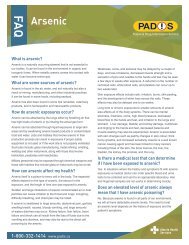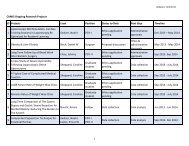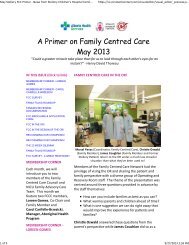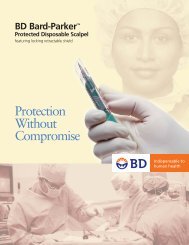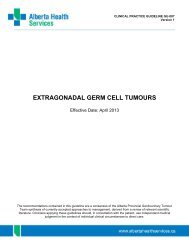Clinical Practice Guideline: Meningioma - Alberta Health Services
Clinical Practice Guideline: Meningioma - Alberta Health Services
Clinical Practice Guideline: Meningioma - Alberta Health Services
You also want an ePaper? Increase the reach of your titles
YUMPU automatically turns print PDFs into web optimized ePapers that Google loves.
CLINICAL PRACTICE GUIDELINE CNS-005<br />
version 2<br />
classic study of 145 patients with meningiomas who underwent gross total resection, Miramanoff et al.<br />
reported disease-free survival rates of 93 percent at five years, 80 percent at 10 years, and 68 percent at<br />
fifteen years. 13 Patients who underwent partial resection had significantly lower disease-free survival rates<br />
in this study: 63 percent at five years, 45 percent at ten years, and only 9 percent at fifteen years. 13<br />
Similarly, in a more recent large series involving 581 patients with grade I meningiomas seen at the Mayo<br />
Clinic between 1978 and 1988, Stafford et al. reported disease-free survival rates of 88 percent at five<br />
years and 75 percent at ten years for completed resected patients, while those rates decreased to 61<br />
percent at five years and 39 percent at ten years for the partially resected patients. 14<br />
Gross total resection should always be the goal of surgery, and offers the best possibility of a cure for lowgrade<br />
meningiomas. However, some meningeal tumours, particularly those involving the cavernous sinus,<br />
petroclival region, posterior aspect of the superior sagittal sinus, or optic nerve sheath, cannot be<br />
completely removed due to their relationship to vital neural or vascular structures. 5 For incompletely<br />
resected or recurrent symptomatic grade I meningiomas, the <strong>Alberta</strong> Provincial CNS Tumour Team<br />
recommends the use of radiotherapy (recommendation #2). In observational studies, external beam<br />
radiotherapy (EBRT) has been shown to decrease recurrence rates in patients with incompletely resected<br />
low-grade meningiomas. Rogers et al. recently conducted a comprehensive review of 23 studies published<br />
during a 24 year period involving 2971 patients treated with either gross total resection alone, partial<br />
resection alone, or partial resection plus adjuvant EBRT. 15 Five-year progression-free survival rates<br />
ranged from 77 to 98 percent for the completely resected patients, 43 to 63 percent for the partially<br />
resected patients who did not receive EBRT, and 80 to 100 percent for the partially resected patients who<br />
received adjuvant EBRT. 15 The <strong>Alberta</strong> Provincial CNS Tumour Team recommends doses of adjuvant<br />
EBRT in the range of 50 to 55 Gy in fractions of 1.8 to 2.0 Gy.<br />
WHO Grades II and III <strong>Meningioma</strong>s<br />
Because high-grade meningiomas are associated with high rates of postsurgical recurrence, the standard<br />
treatment for patients with WHO grades II or III meningiomas is surgery followed by post-operative<br />
radiotherapy (recommendation #3). Although there are no data available from randomized clinical trials,<br />
several retrospective analyses suggest that post-operative radiotherapy is effective in decreasing<br />
recurrence rates for high-grade meningiomas. In a recent review of 119 patients with high-grade<br />
meningiomas who had either complete or incomplete resections and were treated post-operatively with<br />
EBRT, Pasquier et al. reported five- and ten-year disease-free survival rates of 58 and 48 percent,<br />
respectively. 16 Similar progression- and disease-free survival rates have been reported in earlier published<br />
series as well, lending support to the consensus that favours administering EBRT early after surgery for<br />
patients with both completely- and partially-resected high-grade meningiomas. 17-20 For patients with highgrade<br />
meningiomas, the <strong>Alberta</strong> Provincial CNS Tumour Team recommends that post-operative<br />
radiotherapy be delivered at a dose of 54 to 60 Gy, in 1.8 to 2.0 Gy per fraction.<br />
Patients with select tumours may be eligible for stereotactic radiosurgery (SRS), a procedure that utilizes<br />
multiple convergent beams to deliver a single dose of radiation to a discrete treatment area, thereby<br />
minimizing injury to surrounding structures (recommendation #4). This technique is most often used for<br />
patients who have small-to-medium sized meningiomas, have tumours that are surgically inaccessible, are<br />
not candidates for surgery, or have residual or recurrent tumours following surgery. 5,11,15,21 In a<br />
retrospective analysis of 127 patients with meningiomas, Hakim et al. reported one-year overall survival<br />
rates of 91.7 percent for the 26 patients with grade II tumours treated with SRS, and 92.3 percent for the<br />
18 patients with grade III tumours treated with SRS. 22 At four years, the overall survival rates were 83.3<br />
percent for grade II and 21.5 percent for grade III tumours. The median marginal tumour dose in this study<br />
Page 4 of 7



